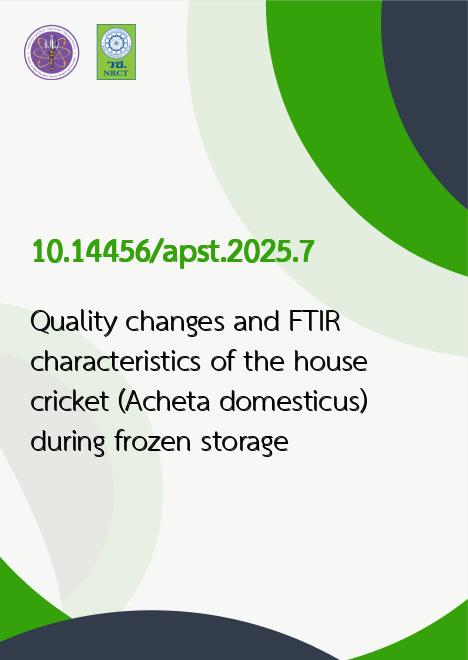
|
Quality changes and FTIR characteristics of the house cricket (Acheta domesticus) during frozen storage |
|---|---|
| รหัสดีโอไอ | |
| Creator | Supawan Thawornchinsombut |
| Title | Quality changes and FTIR characteristics of the house cricket (Acheta domesticus) during frozen storage |
| Contributor | Natcha Kiawsrikul, Kwanruedee Wachirattanapongmetee, Araya Chaoruangrit |
| Publisher | Asia-Pacific Journal of Science and Technology |
| Publication Year | 2568 |
| Journal Title | Asia-Pacific Journal of Science and Technology |
| Journal Vol. | 30 |
| Journal No. | 1 |
| Page no. | 7 (9 pages) |
| Keyword | House cricket, frozen storage, antioxidant glazing, DSC, FTIR |
| URL Website | https://so01.tci-thaijo.org/index.php/APST/ |
| Website title | https://so01.tci-thaijo.org/index.php/APST/article/view/272869 |
| ISSN | 2539-6293 |
| Abstract | This research aimed to evaluate the quality changes during frozen storage (0-4 months) of antioxidant (0.02% Butylated hydroxyanisole (BHA): Butylated hydroxytoluene (BHT)) glazed cricket (AGC). The protein and lipid changes in frozen cricket were determined compared to control (without antioxidant). The results showed that lipid and protein oxidations as evidenced by Thiobarbituric acid reactive substances (TBARS) and protein carbonyl values, respectively, of the control were greater than the AGC up to 2 months of storage (p≤0.05) and then decreased to the comparative levels. The protein solubility of the AGC sample revealed lower values than those which were concomitant with a differential scanning calorimetry (DSC) analysis exhibiting higher thermal stability compared to the control sample. This probably resulted from phenolic antioxidant-protein interactions. The concentrated protein powder from the AGC had a lower rate of lipid oxidation than that from control as proved by the specific Fourier Transform Infrared Spectroscopy (FTIR) bands (i.e. the ratio of absorbances at 3008 cm-1 to 2955 cm-1 and absorbances between 3600-3100 cm-1). These findings suggest that glazing crickets with antioxidants can minimize protein and lipid deviations during frozen storage. |
